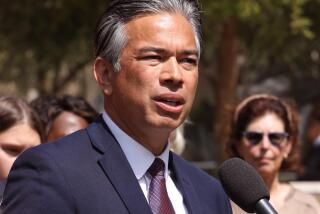Space Camp Lifts Students’ Eyes From Books to Skies
- Share via
SACRAMENTO — Jodie Gabriel, who’d like to attend a new California space agency camp that was announced last week, says she was going to be an attorney until she went to the space camp in Alabama.
Now, the bright eighth-grader says she wants to be an astronaut.
Jodie and two classmates, clad in light-blue space camp overalls, attended a Capitol news conference at which a space agency official and a state senator announced the proposed creation of a space camp and museum in Mountain View. It would be the nation’s second such space camp for youths.
The officials said they aren’t sure just how much the project will cost, probably between $20 million and $30 million, or exactly where the money will come from.
But Sen. Art Torres, a Los Angeles Democrat, said he has introduced a measure that would provide $5 million in state funds for creation of the California Space Academy and National Aeronautics and Space Administration Air and Space Center.
Torres said he has secured bipartisan, two-house support for the measure, with 21 senators and 14 Assembly members signing on as co-authors. The senator said, however, that Gov. George Deukmejian’s Administration has yet to be briefed and announce a position on the proposal.
Other funding for the facility would come from the City of Mountain View and the private sector, with NASA primarily providing spare or obsolete space equipment, said the space agency’s William Ballhaus, director of NASA’s Ames Research Center.
The 20-acre project would be constructed on NASA land, adjacent to the Ames center, he said.
NASA is involved, Ballhaus said, because the space agency is mandated by Congress to disseminate information about its programs.
Targeted for completion in spring of 1990, the project would support itself by charging admission to five-day sessions of year-round space camps for youths from fifth grade to college freshmen. Admission fees would be about $650 per student, with scholarships arranged for disadvantaged children.
In addition, the public could visit an educational and entertainment complex, featuring various exhibits, a theater, and an airplane and rocket park.
The facility would be modeled after the Space and Rocket Center in Huntsville, Ala., which houses the only current space camp. The California center would be run by a nonprofit organization, created by a governing body, the proposed California Aerospace Commission.
California already benefits greatly from NASA’s presence, Torres said. The space agency spends more than $2 billion annually in the state and the Ames Research Center has more than $96 million in contracts with California universities and colleges, he said.
Boost to Economy
The new center would be an additional boost to the economy, drawing an estimated 800,000 tourists annually, Torres said. Air and space museums now comprise four of the nation’s 12 most popular entertainment and educational attractions.
The new center also would aid science and engineering programs in California’s high schools and colleges through outreach programs and the space camp, he said. California currently sends more students to the space camp in Alabama than any other state.
“California’s schools give students a good background in the sciences, but they cannot provide the awe and inspiration of hands-on learning that will take place at the air and space center,” Torres said.
Live Aboard Shuttle
Ballhaus added: “At the space camp, space campers, using training equipment similar to that used by the astronauts, take space walks, study life support systems, work with computers as astronauts do, and learn how to live aboard the space shuttle, space lab and the space station, from suiting up to preparing food, to sleeping.
“Campers ‘fly’ a simulated shuttle mission beginning with checkout, countdown, launch, orbit, and returning to Earth.”
Eighth-grader Dan Garcia said during the news conference simply that the experience at the Alabama camp “overwhelmed” him.
Ninth-grader Natasha Rabe said the NASA camp in Alabama recently provided her what she was missing in her education. “There’s not a lot of science available in schools now,” she said.
Asked about the impact of the space shuttle disaster in 1986, she said: “We have to look to the future, not the past.”
More to Read
Sign up for Essential California
The most important California stories and recommendations in your inbox every morning.
You may occasionally receive promotional content from the Los Angeles Times.













